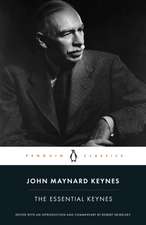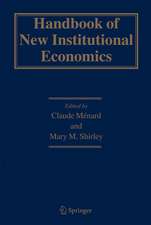Rings in Auctions: An Experimental Approach: Lecture Notes in Economics and Mathematical Systems, cartea 447
Autor Angelo Artaleen Limba Engleză Paperback – 28 ian 1997
Din seria Lecture Notes in Economics and Mathematical Systems
-
 Preț: 360.02 lei
Preț: 360.02 lei -
 Preț: 279.18 lei
Preț: 279.18 lei -
 Preț: 377.51 lei
Preț: 377.51 lei -
 Preț: 377.69 lei
Preț: 377.69 lei -
 Preț: 373.72 lei
Preț: 373.72 lei -
 Preț: 438.78 lei
Preț: 438.78 lei -
 Preț: 489.03 lei
Preț: 489.03 lei -
 Preț: 374.46 lei
Preț: 374.46 lei -
 Preț: 378.43 lei
Preț: 378.43 lei -
 Preț: 372.00 lei
Preț: 372.00 lei -
 Preț: 392.98 lei
Preț: 392.98 lei - 20%
 Preț: 354.88 lei
Preț: 354.88 lei - 15%
 Preț: 632.33 lei
Preț: 632.33 lei -
 Preț: 372.76 lei
Preț: 372.76 lei -
 Preț: 404.74 lei
Preț: 404.74 lei -
 Preț: 379.18 lei
Preț: 379.18 lei - 15%
 Preț: 633.64 lei
Preț: 633.64 lei -
 Preț: 372.76 lei
Preț: 372.76 lei -
 Preț: 339.74 lei
Preț: 339.74 lei -
 Preț: 418.66 lei
Preț: 418.66 lei -
 Preț: 372.00 lei
Preț: 372.00 lei - 18%
 Preț: 762.56 lei
Preț: 762.56 lei -
 Preț: 386.01 lei
Preț: 386.01 lei -
 Preț: 394.89 lei
Preț: 394.89 lei - 15%
 Preț: 635.55 lei
Preț: 635.55 lei -
 Preț: 375.80 lei
Preț: 375.80 lei -
 Preț: 372.00 lei
Preț: 372.00 lei - 15%
 Preț: 626.86 lei
Preț: 626.86 lei - 15%
 Preț: 636.36 lei
Preț: 636.36 lei -
 Preț: 371.42 lei
Preț: 371.42 lei -
 Preț: 440.33 lei
Preț: 440.33 lei - 15%
 Preț: 633.64 lei
Preț: 633.64 lei -
 Preț: 379.54 lei
Preț: 379.54 lei - 15%
 Preț: 643.42 lei
Preț: 643.42 lei -
 Preț: 408.06 lei
Preț: 408.06 lei -
 Preț: 404.65 lei
Preț: 404.65 lei -
 Preț: 392.24 lei
Preț: 392.24 lei -
 Preț: 392.24 lei
Preț: 392.24 lei -
 Preț: 386.18 lei
Preț: 386.18 lei - 15%
 Preț: 624.77 lei
Preț: 624.77 lei - 20%
 Preț: 642.56 lei
Preț: 642.56 lei -
 Preț: 373.51 lei
Preț: 373.51 lei -
 Preț: 487.17 lei
Preț: 487.17 lei -
 Preț: 440.49 lei
Preț: 440.49 lei -
 Preț: 372.37 lei
Preț: 372.37 lei - 15%
 Preț: 626.41 lei
Preț: 626.41 lei -
 Preț: 379.39 lei
Preț: 379.39 lei -
 Preț: 372.21 lei
Preț: 372.21 lei - 15%
 Preț: 655.34 lei
Preț: 655.34 lei
Preț: 375.60 lei
Nou
Puncte Express: 563
Preț estimativ în valută:
71.90€ • 73.95$ • 59.65£
71.90€ • 73.95$ • 59.65£
Carte tipărită la comandă
Livrare economică 19 februarie-05 martie
Preluare comenzi: 021 569.72.76
Specificații
ISBN-13: 9783540619307
ISBN-10: 3540619305
Pagini: 188
Ilustrații: X, 174 p. 8 illus.
Dimensiuni: 155 x 235 x 10 mm
Greutate: 0.27 kg
Ediția:1997
Editura: Springer Berlin, Heidelberg
Colecția Springer
Seria Lecture Notes in Economics and Mathematical Systems
Locul publicării:Berlin, Heidelberg, Germany
ISBN-10: 3540619305
Pagini: 188
Ilustrații: X, 174 p. 8 illus.
Dimensiuni: 155 x 235 x 10 mm
Greutate: 0.27 kg
Ediția:1997
Editura: Springer Berlin, Heidelberg
Colecția Springer
Seria Lecture Notes in Economics and Mathematical Systems
Locul publicării:Berlin, Heidelberg, Germany
Public țintă
ResearchCuprins
1 Introduction.- 2 The Experiment.- 2.1 Introduction and Related Literature.- 2.2 Experimental Design.- 2.3 Theory of Collusion in First-price Auctions.- 2.4 Experimental Results.- 2.5 Theoretical Predictions versus Data.- 2.6 Other Mechanisms.- 2.7 Strategic Behavior and the End Effect.- 3 A Descriptive Model.- 3.1 Conditional Probabilities.- 3.2 The Model.- 4 Mechanisms of Collusion.- 4.1 The Distribution Function.- 4.2 Announcement Mechanism.- 4.3 Bid-bargain Mechanism.- 4.4 Lattice Mechanism.- 4.5 First-Price Auction Mechanism.- 4.6 Summing Up.- 5 Two Extensions.- 5.1 Lattice With Continuous Bids.- 5.2 Two-player Coalition.- 6 Conclusion.- A Instructions and Forms.- B Experimental Data.- C Experimental Data.- D Non-cooperative Bidding.- E Player 2’s Equilibrium Strategy.- List of Figures.- List of Tables.











